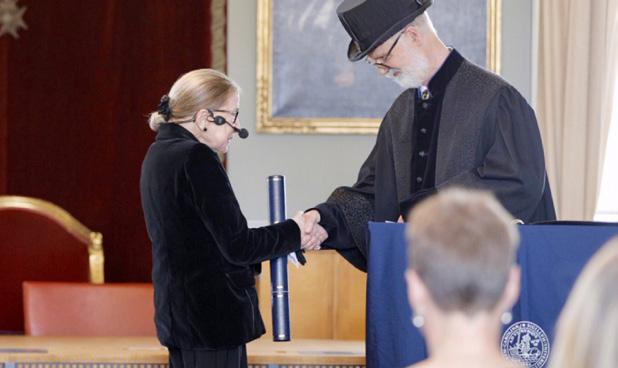[
Swedish Headlines
]
More women Nobel laureates than usual this year The 2020 Nobel Prize By Peter Berlin
T
his year’s Nobel Prize winners were notified of their awards on October 5 – 12. The prize winners would normally receive their prize from King Carl XVI Gustaf at a formal ceremony in Stockholm on December 10th. Due to the coronavirus pandemic, the in-situ ceremony has been cancelled this year and has been replaced by a televised ceremony showing the laureates receiving their awards in their home countries. Each Nobel Prize comes with a medal and a prize sum of 10 million Swedish kronor (about $1.1 million), to be shared as appropriate among the winners of that category.
Left to right: Medicine laureates Harvey J. Alter, Michael Houghton and Charles M. Rice.
Physiology or Medicine: On Monday, October 5, Americans Harvey Alter and Charles Rice together with Michael Houghton from the UK were notified of their Nobel Prize awards in Medicine. The award was for their discovery of the Hepatitis C virus. The three were honoured for their “decisive contribution to the fight against blood-borne hepatitis, a major global health problem that causes cirrhosis and liver cancer in people around the world,” the jury said. Physics: On Tuesday October 6, Roger Penrose of Britain, Reinhard
[]
Swedish Press | November 2020 6
Left to right: Physics laureates Roger Penrose, Reinhard Genzel and Andrea Ghez.
Genzel of Germany and Andrea Ghez of the US won the Nobel Prize in Physics for showing the connection between the theory of relativity and black holes. The term “black hole” refers to a point in space where matter is so dense as to create a gravity field from which nothing can escape, not even light (hence the “blackness”). Chemistry: On Wednesday, October 7, the Nobel Committee announced that Emmanuelle Charpentier of France and Jennifer Doudna of the US won the Nobel Prize in Chemistry for developing the geneediting technique known as the CRISPR-Cas9 DNA snipping “scissors.” “Using these, researchers can change the DNA of animals, plants and microorganisms with extremely high precision. This technology has had a revolutionary impact on the life sciences, is contributing to new cancer therapies and may make the dream of curing inherited diseases come true,” the jury said.
Left to right: Chemistry laureates Emmanuelle Charpentier, Jennifer Doudna and Literature laureate Louise Glück.
Literature: On Thursday, October 8, Louise Glück of US was informed by the Novbel Committee that she had
been awarded the 2020 Nobel Prize in Literature. Glück, a professor of English at Yale University, was honoured “for her unmistakable poetic voice that with austere beauty makes individual existence universal,” the Swedish Academy stated. Peace: On Friday, October 9, the Norwegian Nobel Committee awarded the 2020 Peace Prize to the World Food Program (WFP) of the United Nations. Berit Reiss-Andersen, the Committee Chairperson, pointed out that food is often used as a weapon in military conflicts, e.g. by destroying and burning harvests. As such, the weapon is particularly disastrous in countries and communities where the population is starving. Improving food supply security will not only stave off hunger but may also increase the prospects of peace.
Left to right: Economic Sciences laureates Paul R. Milgrom and Robert B. Wilson.
Economics: On Monday 12
October, American economists Paul Milgrom and Robert Wilson won the Nobel Economics Prize for their work on commercial auctions. The duo was honoured “for improvements to auction theory and inventions of new auction formats,” the jury said. It noted that the discoveries by Milgrom and Wilson “have benefitted sellers, buyers and taxpayers around the world.” Illustrations © Nobel Media. Ill. Niklas Elmehed










